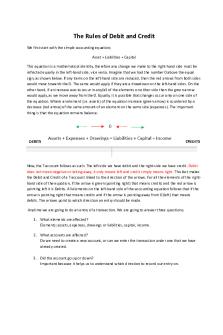Practice Questions for using the rules of multiplication and addition in genetic crosses PDF

| Title | Practice Questions for using the rules of multiplication and addition in genetic crosses |
|---|---|
| Author | Anonymous User |
| Course | Test Bank for Global Health 101 2nd edition by Richard Skolnik |
| Institution | Qafqaz Universiteti |
| Pages | 2 |
| File Size | 72.8 KB |
| File Type | |
| Total Downloads | 26 |
| Total Views | 192 |
Summary
Download Practice Questions for using the rules of multiplication and addition in genetic crosses PDF
Description
Practice questions for using the rules of multiplication and addition in genetic crosses Q - When do we us the rule of multiplication? A - When we have independent events in sequence. You multiply the probabilities of the independent sequential events. Example: In heterozygous pea plants (Pp) what is the probability that the offspring (Pp xPp) will be homozygous recessive? Pp x Pp The chance of the first parent (Pp) passing on p (little p) is ½ and the second parent (Pp) is also ½. Therefore ½ x ½ = ¼ OK that is simple. In a trihybridcross between AABbCC X AaBbCc what is the probability that the offspring will be AaBbCC? Just work on each letter combination at a time. You can use a punnett square initially but you will soon learn the probabilities. AABbCC X AaBbCc resulting in AaBbCC so Aa =2/4 or ½
A a
A AA Aa
A AA Aa
Bb X Bb resulting in Bb is ½ CC X Cc resulting in CC is ½ Therefore what is the probability that a cross between AABbCC X AaBbCc will produce offspring that are AaBbCC is ½ x ½ x ½ = 1/8
OK now practice this. 1. Parents = aaBbCC x aabbCc What is the probability that offspring will be aabbcc (recessive for all alleles)? 2. Parents are WwYYZz x wwyyZZ What is the probability that offspring will be WwYyZz? (heterozygous for all alleles)?
Q - When do we us the rule of addition? A - When we have two or more mutually exclusive events. Example: What is the probability that the offspring from a cross between WwYyZz x WwYYZZ will be WWYyZz or WWYYZZ? So first you do the same as above and use the rule of multiplication to work out the probability for each: WwYyZz x WwYYZZ WWYyZz = Ww ¼ x Yy ½ x Zz ½ = 1/16 WWYYZZ = WW ¼ x YY ½ x ZZ ½ = 1/16 Then you add the probabilities of these mutually exclusive events together. 1/16 + 1/16 = 2/16 or 1/8 so there is a 1/8 probability that the offspring from a cross between WwYyZz x WwYYZZ will be WWYyZz or WWYYZZ.
OK, now practice a few of these: 1. What is the probability that the offspring from a cross between SsTtVv x SsTtVV will be SSTTVV or ssttVV? 2. What is the probability that the offspring from a cross between CCDDEe x ccDdEe will be CcDDee or CCDdtEE? Slightly more complicated. 3. What is the probability that the offspring from a cross between CCDdee x CcDdEe will be dominant for at least 2 of the 3 characters? (hint: work out the probabilities for each offspring that has at least 2 dominant character using the multiplication rule then use the rule of addition) I will post the answers on Monday....
Similar Free PDFs

Binary Multiplication Practice
- 2 Pages

Rules Structure-and-Practice
- 4 Pages

Practice Questions for the Midterm
- 109 Pages

Binary Addition Practice
- 2 Pages

Lab6-Using rules and building blocks
- 14 Pages

The Rules of Debit and Credit
- 4 Pages
Popular Institutions
- Tinajero National High School - Annex
- Politeknik Caltex Riau
- Yokohama City University
- SGT University
- University of Al-Qadisiyah
- Divine Word College of Vigan
- Techniek College Rotterdam
- Universidade de Santiago
- Universiti Teknologi MARA Cawangan Johor Kampus Pasir Gudang
- Poltekkes Kemenkes Yogyakarta
- Baguio City National High School
- Colegio san marcos
- preparatoria uno
- Centro de Bachillerato Tecnológico Industrial y de Servicios No. 107
- Dalian Maritime University
- Quang Trung Secondary School
- Colegio Tecnológico en Informática
- Corporación Regional de Educación Superior
- Grupo CEDVA
- Dar Al Uloom University
- Centro de Estudios Preuniversitarios de la Universidad Nacional de Ingeniería
- 上智大学
- Aakash International School, Nuna Majara
- San Felipe Neri Catholic School
- Kang Chiao International School - New Taipei City
- Misamis Occidental National High School
- Institución Educativa Escuela Normal Juan Ladrilleros
- Kolehiyo ng Pantukan
- Batanes State College
- Instituto Continental
- Sekolah Menengah Kejuruan Kesehatan Kaltara (Tarakan)
- Colegio de La Inmaculada Concepcion - Cebu









